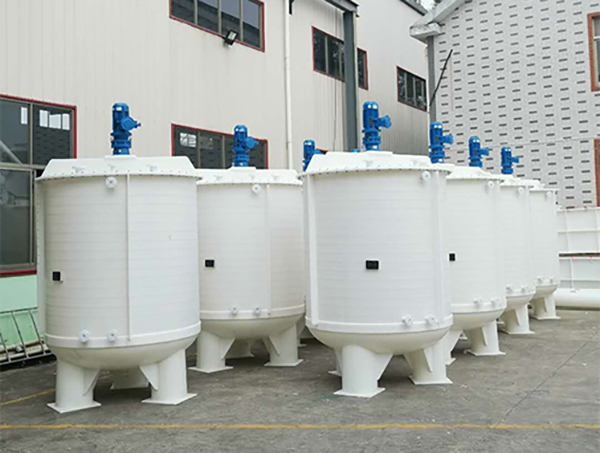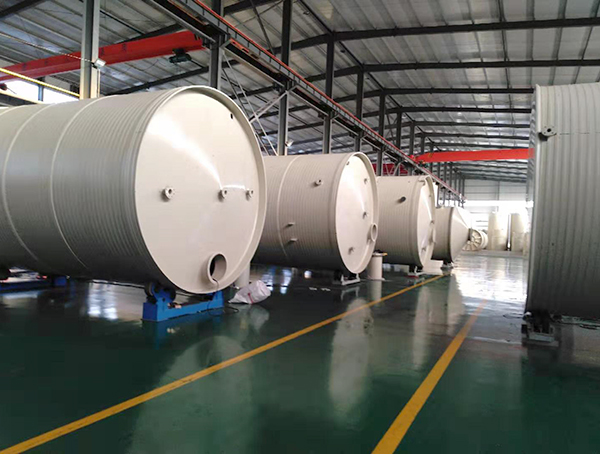Hechi PPH storage tank manufacturer
During the processing of PPH winding tank, there are three core points: tank body fabrication, internal and external weld welding, and manhole installation. These three core points will affect the integrity, aging resistance, leakage resistance, service life, mechanical strength and other properties of the tank. PPH granular material is melted on the spiral extrusion winding unit, and then the melted extrusion material forms a tank on the mold, and demoulding is carried out after the temperature is reduced to a certain degree, so as to ensure the integrity of the tank. However, the traditional processing method is plate butt welding to form a tank body. Since the z width of the plate is 2000 mm and the tank body height is generally more than 2000 mm, in actual processing, the tank body is formed by manual welding of sections of the tank body. Then, to be safe, a stiffening ring is added at the joint of the tank body. PPH winding tank is formed by direct processing of PPH particles, without secondary processing. Traditionally, particles are processed into plates, and then the plates are processed into tank bodies; In addition, the PPH winding tank has no problems of joints, welds and leakage, and the overall mechanical strength is far greater than that of tanks processed by traditional processes because of the need for chamfer welding.

Hechi PPH storage tank manufacturer
PPH storage tank vertical storage tank is a plastic storage tank made of PPH granular materials after processing. The barrel of PPH storage tank is made of PPH granules through extrusion and winding process, and the product is formed at one time without welding. PPH storage tank is made of polypropylene plate by welding. From the perspective of corrosion resistance, the corrosion resistance of PPH vertical storage tank is similar to that of PPH vertical storage tank. From the perspective of safety performance, the PPH tank cylinder is integrally formed without welding and leakage, while the PPH tank is welded, which is easy to cause leakage and increase unsafe factors. And there is a big gap between the other properties of the two, such as anti-aging performance. The nozzle installation is the last process, which is equivalent to the reduced version of bottom welding. That is, the imported small automatic extrusion welding unit is used to weld the connecting pipe and flange into shape, and then the hole opener is used to cut the corresponding caliber on the tank body, and then the domestic portable extrusion welding is used. PPH storage tanks are widely used in chemical, pharmaceutical, dye, chemical fiber, metallurgy, textile and other industries to store various corrosive media. The utility model has the advantages of long service life of corrosion resistance, light self weight, safe transportation, convenient maintenance, etc.

Hechi PPH storage tank manufacturer
The storage tank is a new spiral wound disposable product with no welding cracks and better sealing performance. The thickness of PPH storage tank is not affected by the manufacturing materials. The external welding of PPH storage tank is a process that uses the imported automatic extrusion welding unit to make the large weld of the storage tank with high stress be welded in one time. The new PPH granular material with the same property as the tank body is hot melted at the large weld seam, and is integrated with the tank bottom and tank body. Welding process characteristics of PPH storage tank bottom: high mechanization and automation, stable product quality; The weld specifications can be designed according to the stress characteristics of the products, so as to give full play to the integrity of the weld; It can reduce flash, and the joints are smooth and beautiful.
Hechi PPH storage tank manufacturer
PPH storage tank is also a polypropylene storage tank. Polypropylene can be divided into many types, and PPH is only one of them. PPH storage tank has great advantages in strength, acid and alkali resistance, aging resistance and appearance. The plastic storage tank is made of polypropylene (PP), reinforced polypropylene (PPH) and other raw materials, and is integrally molded by a special rotational molding process. There are no welding, no leakage, light weight, aging resistance, impact resistance, corrosion resistance, and long service life. So there is only one letter difference between PPH storage tank and PP storage tank. Is there any relationship between them? Don't tell me, there are really connections and differences. Let's get to know. PPH storage tank is formed by using alloy polypropylene technology at one time, but PP storage tank is rolled with polypropylene sheet, so its anti-corrosion performance will be much lower. PPH storage tank is more resistant to temperature than ordinary polypropylene, and can resist the erosion of strong chemicals. In addition, the properties of PP material and PPH material are similar, acid and alkali resistant and corrosion resistant. PPH storage tank is more expensive than PP storage tank. The plastic storage tank has great performance in terms of performance and is relatively durable. To some extent, it is a kind of tank that cannot be replaced by ordinary storage tanks.

Hechi PPH storage tank manufacturer
When PPH storage tank is used, the filling rate shall not be greater than 95%, and excessive filling is strictly prohibited. Made of polypropylene, it can contain inorganic acid, malic acid, salt, ammonium, alkali, oil and most gaseous compounds under normal temperature and pressure; The lower cracking temperature and dissolution temperature of PPH storage tank are - 70 ℃ to 108 ℃, and the temperature of the liquid contained is usually between - 40 ℃ and 60 ℃; The filling rate of PPH storage tank shall not be greater than 95% when it is used, and excessive filling is strictly prohibited; When the valves, instruments, pipes, etc. on the equipment are frozen, nitrogen, air or hot water at 70~80 ℃ shall be used for thawing, and open fire heating is strictly prohibited; The PPH storage tank shall be equipped with acid and alkali resistant gaskets when containing acid and alkali liquids, and insoluble rubber gaskets when containing organic solvents; If you are not sure whether you can contain the required substances, you can consult our technical personnel, and if necessary, you can carry out the tank material sample soaking test.









